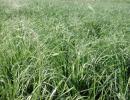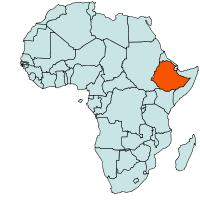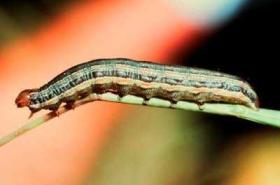Teff
 |
Teff
Scientific name:
Eragrostis tef
Family:
Cyperales: Poaceae
Local names:
Teff (Amharic); Taffi (Oromo); Taff (Tigrigna)
Common names:
Lovegrass / Annual Bunch Grass (English) / Mil éthiopien (French).
Pests and Diseases: African armyworm
Purple witchweed
|
 |
| Geographical Distribution of Teff in Africa |
The word tef is thought to originate from the Amharic word "teffa", which means lost (due to small size of the grain), or from the Arabic word "tahf" used by Semites in South Arabia.
Teff is an important food grain in Ethiopia and Eritrea, where it is used to make injera. Because of its small seeds (less than 1 mm diametre), a person can hold enough to sow an entire field in 1 hand. This property makes teff particularly suited to a semi-nomadic lifestyle.
Nutritive Value per 100 g of edible Portion
| Raw or Cooked Teff | Food Energy (Calories / %Daily Value*) |
Carbohydrates (g / %DV) |
Fat (g / %DV) |
Protein (g / %DV) |
Calcium (g / %DV) |
Phosphorus (mg / %DV) |
Iron (mg / %DV) |
Potassium (mg / %DV) |
Vitamin A (I.U) |
Vitamin C (I.U) |
Vitamin B 6 (I.U) |
Vitamin B 12 (I.U) |
Thiamine (mg / %DV) |
Riboflavin (mg / %DV) |
Ash (g / %DV) |
| Teff cooked | 101 / 5% | 19.9 / 7% | 0.7 / 1% | 3.9 / 8% | - | - | - | - | 2.0 IU / 0% | - | 0.1 / 5% | 0.0 / 0% | 0.2 / 12% | 0.0 / 2% | 0.7 |
| Teff uncooked | 367 / 18% | 73.1 / 24% | 2.4 / 4% | 13.3 / 27% | 180.0 / 18% | 429 / 43% | 7.6 / 42% | 427 / 12% | 9.0 IU / 0% | - | 0.5 / 24% | - | 0.4 / 26% | 0.3 / 16% | 2.4 |
Climate conditions, soil and water management:
It is adapted to environments ranging from drought stress to water logged soil conditions. Maximum teff production occurs at altitudes of 1800 to 2100 m, with a temperature range of 10 to 27 °C. Average annual rainfall is about 750-1000 mm in the central Ethiopian highlands. Maximum rainfall in the area of cultivation is about 2500 mm. However, teff could produce good yields at much lower annual rainfalls: for most cultivars 300-500 mm of rainfall per growing season is adequate. Early maturing varieties (60-75 days) can do with less than 300 mm of seasonal rainfall. Teff is day length sensitive and flowers best during 12 hours of daylight.Propagation and Planting:
Ethiopian farmers grow teff either as a staple or as a standby. As a staple, they plant it like other cereals, but they normally sow it late and harvest it well into the dry season. As a standby, they wait until their main crops maize, sorghum, or maybe wheat shows signs of failing. Then they sow a fast-maturing tef as a backup source of sustenance in case of disaster. (Lost Crops of Africa: Vol. I: Grains (1996). Husbandry:
Teff requires little care once it is established. Its rapid growth stifles most weeds; few diseases and pests attack it; and it is said to produce well without added nutrients. However, in most places teff will respond to fertilisers. In Ethiopia, large yield improvements can be achieved by applying techniques that are already known: careful land preparation, use of selected seeds, fertilisation, sowing and weeding at the optimum time, and disease and pest control, for example. (Lost Crops of Africa: Vol. I: Grains (1996). Harvesting:
Teff threshes well with standard methods and equipment. Very early-maturing types are ready to harvest in 45-60 days; early types in 60-120 days; and late types in 120-160 days.Yields range from 300 to 3,000 kg per hectare, or even more. Although the national average in Ethiopia is 910 kg per hectare, yields of 2,000-2,200 kg per hectare are considered routinely attainable if good agronomic practices are carefully followed. Yields of 2,000 kg per hectare have been achieved on South African farms also, although storms have sometimes levelled the fields, resulting in large losses.
The grain is easy to store and will survive for many years in traditional storehouses without damage by insects. This makes it a valuable safeguard against famine. (Lost Crops of Africa: Vol. I: Grains (1996).
The African armyworm (Spodoptera exempta)
It is an occasional but seriously destructive pest on teff in Ethiopia. It causes serious damage to young plants in years of armyworm outbreaks. The caterpillars feed on the leaves eating them down to the midrib. Outbreaks usually start during May in the southern provinces of Ethiopia. During the main growing season they move northwards.
What to do:
- Monitor regularly field margins, low areas where plants have lodged, beneath plant debris around the base of plants, on the ground, and underneath the plant leaves. Check daily young crops if conditions are known to be favourable to the pest.
- Spray Bt or botanicals such as neem and pyrethrum extracts. Spray when caterpillars are small. Once caterpillars are mature (about 3 to 3.5 cm long) they may have cause serious damage and it may no longer be economical to treat the crop. For more information on (neem click here, for pyrethrum click here and for Bt click here)
- Conserve and encourage natural enemies. For more information on natural enemies click here
- Practise field sanitation. For more information on field sanitation click here

African armyworm (Spodotera exempta). Mature caterpillars measure up to 4 cm.
© University of Arkansas
- Germer, Renate (1985). Flora des pharaonischen Ägypten. Mainz: von Zabern. ISBN 3805306202.
- Insect pests of cereals in Ethiopia. www.ethiopia.ipm-info.org
- Lost Crops of Africa: Volume I: Grains (1996). NATIONAL RESEARCH COUNCIL Division on Policy and Global Affairs Development, Security, and Cooperation. Free online-version available: National Academies Press: www.nap.edu
- Nutrition Data www.nutritiondata.com.
- Wikipedia, the free encyclopedia www.en.wikipedia.org